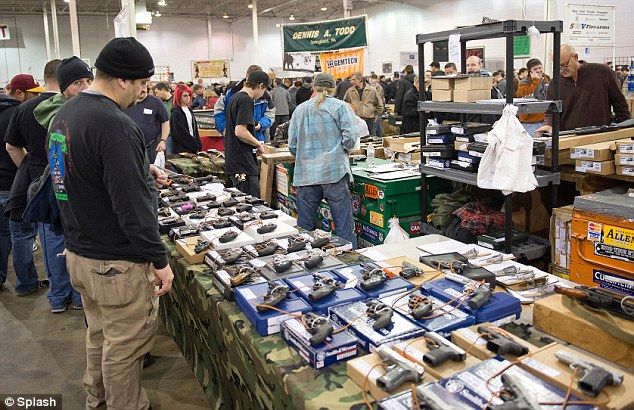
White guys at gun show.
"Gun Cartoons and Gun Violence Bibliography"
"Gun Cartoons and Gun Violence Bibliography"
A Blow-By-Blow Guide To 69 Mass Killings In Last 3 Decades. Mostly White Perps. Few Blacks
http://paxonbothhouses.blogspot.com/2015/03/a-blow-by-blow-guide-to-69-mass.html
Handguns At Home And The Scourge Of Suicide Among Young People
A Blow-By-Blow Guide To 69 Mass Killings In Last 3 Decades. Mostly White Perps. Few Blacks
http://paxonbothhouses.blogspot.com/2015/03/a-blow-by-blow-guide-to-69-mass.html
http://paxonbothhouses.blogspot.com/2015/03/a-blow-by-blow-guide-to-69-mass.html
Handguns At Home And The Scourge Of Suicide Among Young People
80 Percent Of All Firearm Deaths In 23 Industrialized Countries Occurred In The US
Diane Rehm Guest Gets To The Nub Of Police Violence And How Easily It's Prevented
Pattern in shooters: Most are white men
No one really knows what prompted Lanza’s actions, so theories and commentaries about the gender and racial dynamics of his crimes are debatable at best.
But the fact remains that the overwhelming majority of mass shootings in the United States have been committed by men — most of whom were white.
The racial and gender dynamics of such crimes are rarely discussed or probed in the aftermath of these crimes. More attention is paid when the perpetrator doesn’t fit the prevailing pattern.
Many media commentators, including some in the Korean American community, speculated on the role that Seung Hui Cho’s Korean background played in the 2007 shootings at Virginia Tech. Also, many wondered if alleged Fort Hood shooter Nidal Malik Hasan’s Muslim background played a role in that crime.
White males have no monopoly on mass killings; relative to population, African Americans are overrepresented among the perpetrators of crimes involving the death of four or more people, according to criminologist James Alan Fox. These crimes include robberies gone awry, gang-related slayings and family disputes. But white men carried out or were accused of many of the most notorious episodes of random public killings in recent decades, from Oklahoma City to Columbine to Tucson to Aurora to Newtown.
Of 62 mass shootings in public places during the past 30 years, 44 were done by white males, according to a tally by Mother Jones magazine. Only one assailant was a woman.
These factors rarely draw much comment or exploration in media accounts in the wake of these crimes. More often, the discussion focuses on mental health, family relations, gun control or such alleged cultural influences as violent video games, TV programs or movies.
“If a woman were the shooter, you can bet there would be all sorts of commentary about shifting cultural notions of femininity and how they might have contributed to her act,” wrote Jackson Katz, a filmmaker and writer, in the Huffington Post. “ . . . The key difference is that because men represent the dominant gender, their gender is rendered invisible in the discourse about violence.”
Women infrequently commit homicides and only then under specific circumstances. Women tend to kill people they know — boyfriends, spouses, their children; “stranger” killings by women are almost unheard of, says Randolph Roth, a history and sociology professor at Ohio State University. “When women kill, it’s personal,” he says. “They kill because they hate you.”
Men, on the other hand, kill for a variety of reasons and sometimes for no apparent reason. “Men carry this kind of anger,” Roth says. “It’s there.”
Similar violence has been observed in male chimps; after being defeated by a dominant rival, they will sulk for days — and then attack another chimp in a sudden, seemingly random outburst.
Understanding the effects of race and culture on the minds of mass killers is complicated by many factors, not least of which is the fact that many kill themselves before anyone can ask, “Why?”
But both Roth and Fox suggest that many violent episodes are linked by the killers’sense of having been denied something he thought he was rightfully his — a job, a promotion, status of some kind. The profound sense of failure and resentment that accompanies such setbacks may be stronger in white men than others. Accused Aurora, Colo., shooter James Holmes had failed in his PhD program; Oklahoma City bomber Timothy McVeigh had washed out of Ranger school.
“There’s a feeling of entitlement that white men have that black men don’t,” says Fox, a professor at Northeastern University and co-author of “Extreme Killing.” “They often complain that their job was taken by blacks or Mexicans or Jews. They feel that a well-paid job is their birthright. It’s a blow to their psyche when they lose that. . . . If you’re a member of a group that hasn’t historically experienced unemployment, there’s a far greater stigma to [losing a job] than those who have.”
A perhaps telling statistic: About 60 percent of mass killers are older than 30, an indication, Fox says, that “it takes years to develop the level of frustration and anger” that expresses itself as indiscriminate murder.
It’s not just the killer whose race matters, he says, but the victims’, too. Incidents in which the dead are poor, nonwhite or of immigrant background tend to get less attention from the media than other mass shootings.
The killing of five children (and wounding of 29) at an elementary school in Stockton, Calif., in 1989, for example, was forgotten long before the attacks at Columbine High School in suburban Denver a decade later, he says, possibly because the young victims in the first crime were refugees from Southeast Asia, and in the latter, the victims were middle- and upper-middle-class teens. The Stockton shooter was a white, unemployed man.
Similarly, the massacres of 13 people in Binghamton, N.Y., in 2009 and seven people at a small college in Oakland, Calif., this year attracted far less attention than the Aurora killings, despite similar body counts. In both of those cases, the alleged perpetrators and almost all of the victims were poor or working-class immigrants.

No comments:
Post a Comment